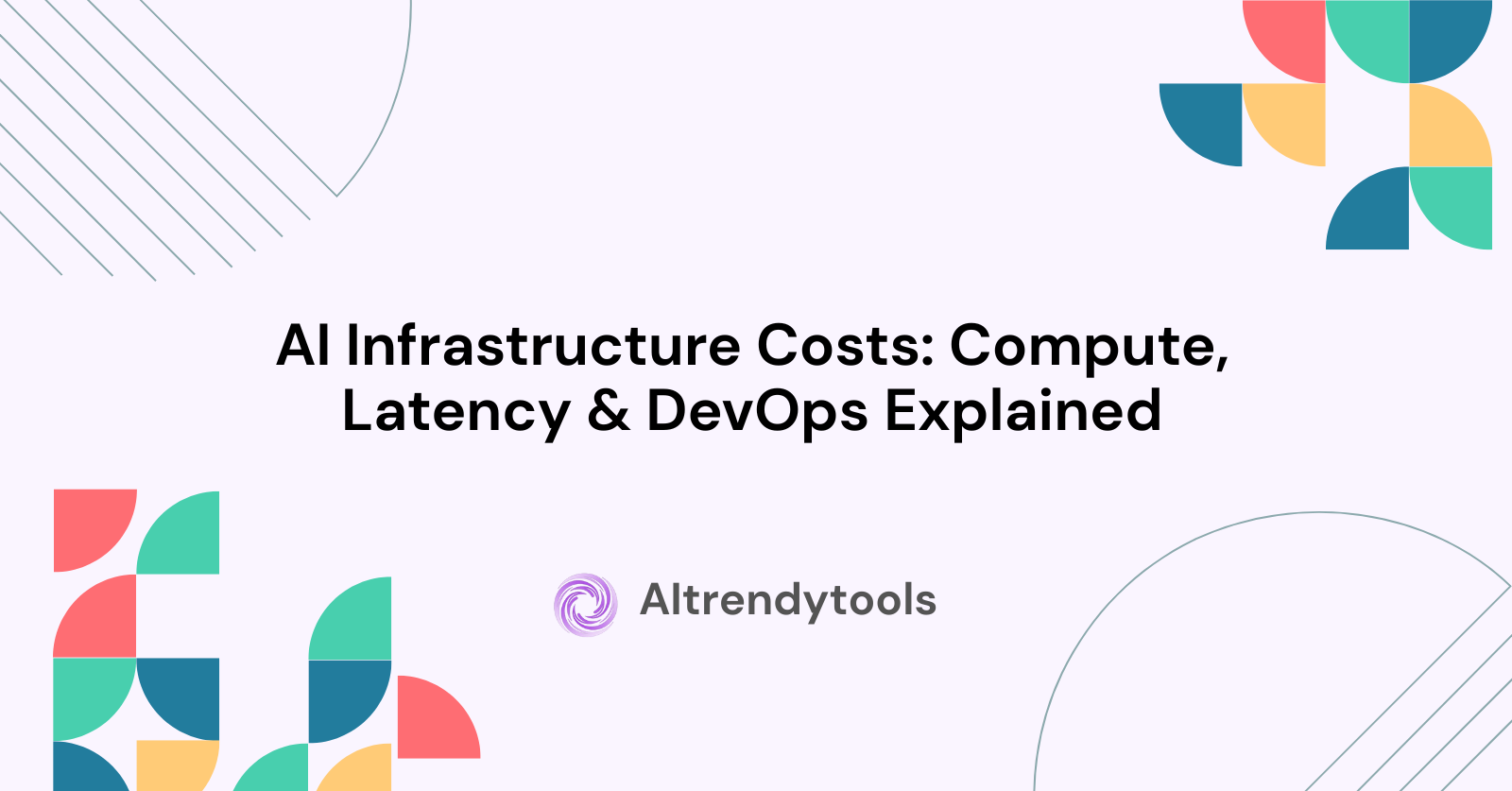🔥 AITrendytools: The Fastest-Growing AI Platform |
Write for usAI Infrastructure Costs: Compute, Latency & DevOps Explained
Discover the hidden costs of AI infrastructure beyond GPUs. Learn real-world compute expenses, latency challenges & DevOps overhead from our experience.
Nov 24, 2025
When we launched our first AI-powered feature at our SaaS startup last year, we budgeted $5,000 monthly for compute costs. Three months later, our actual spend hit $18,000—and that was just the beginning of understanding AI infrastructure's true price tag.
Most founders and engineering teams see the sticker price on GPU instances or API calls and think they've captured the full cost. They haven't. The real expenses hide in three overlooked areas: compute inefficiencies, latency management, and DevOps complexity. After burning through our initial infrastructure budget and conducting a comprehensive audit, we've identified where money actually goes—and how to avoid the same mistakes.
Why AI Infrastructure Costs More Than You Think
Traditional software infrastructure follows predictable patterns. You provision servers, scale based on traffic, and costs increase linearly. AI infrastructure operates differently. A single model inference might consume 100x the resources of a standard API call, and costs scale exponentially with model complexity and user demand.
The 2024-2025 shift toward production AI has exposed this reality across the industry. Companies aren't just experimenting anymore—they're deploying models that handle millions of daily requests. This operational scale reveals costs that sandbox testing never showed.
The Three Hidden Cost Centers
1. Compute: Beyond the GPU Price Tag
The obvious cost is GPU rental or cloud inference APIs. What catches teams off-guard are the auxiliary compute expenses.
Cold Start Penalties When your model isn't continuously running, spinning up instances takes time—and money. We discovered our serverless model deployment incurred cold starts on 40% of requests during off-peak hours. Each cold start wasted 8-12 seconds and doubled the compute cost per request because you're paying for initialization time that serves no users.
Our solution involved maintaining a "warm pool" of standby instances during business hours, which increased baseline costs by $800 monthly but eliminated $2,400 in wasted cold start compute.
Model Loading and Memory Large language models and computer vision models require substantial RAM. A 7B parameter model needs approximately 14GB just to load into memory. If you're running multiple models or different versions simultaneously for A/B testing, memory requirements multiply quickly.
We initially underspecified our instance memory, causing frequent out-of-memory crashes. Upgrading to memory-optimized instances added 35% to our compute bill but reduced failed requests from 8% to under 0.5%.
Batch Processing vs Real-Time Inference Real-time inference costs more per request than batch processing, yet many use cases don't genuinely need instant responses. We analyzed our user behavior and found that 60% of our AI features could tolerate 2-5 second delays.
By implementing a smart queue system that batches requests intelligently, we reduced compute costs by 40% for those use cases. The key was transparent user communication—adding a simple "Processing your request..." indicator maintained user satisfaction while dramatically cutting infrastructure spend.
2. Latency: The Performance-Cost Tradeoff
Latency affects both user experience and your wallet. Every millisecond matters, but achieving low latency requires expensive infrastructure decisions.
Geographic Distribution To serve global users with acceptable latency, you need model deployments in multiple regions. This means duplicate infrastructure across continents. For our user base in North America, Europe, and Southeast Asia, we maintain three separate deployments.
Regional redundancy tripled our baseline compute costs but reduced average response times from 2.3 seconds to 0.7 seconds. More importantly, our user engagement metrics improved by 23% when we dropped below the critical 1-second threshold.
Edge Computing Premium Edge deployment promises lower latency by moving compute closer to users. In practice, edge infrastructure costs 2-4x more than centralized cloud compute for equivalent resources.
We tested edge deployment for our image processing pipeline. While latency improved from 450ms to 180ms, costs increased from $0.04 per 1,000 requests to $0.15. For our high-volume feature, that translated to an additional $3,300 monthly. We ultimately kept edge deployment only for our premium tier users, making it a value-added feature that justified its cost.
Caching Strategies and Their Limits Aggressive caching reduces both latency and compute costs—when it works. We implemented Redis caching for frequent queries and saw our cache hit rate reach 35%, saving roughly $1,800 monthly.
However, AI outputs aren't always cacheable. Personalized responses, time-sensitive data, or dynamic prompts can't be cached effectively. We learned to identify which features benefit from caching versus which need fresh inference every time.
3. DevOps: The Operational Overhead Nobody Budgets For
The human cost of managing AI infrastructure often exceeds the compute costs, yet it's rarely included in initial budgets.
Monitoring and Observability Traditional application monitoring doesn't capture what you need for AI systems. You need to track model performance, inference latency, accuracy drift, failure rates, and resource utilization—across potentially dozens of model versions.
We implemented Weights & Biases for model monitoring and DataDog for infrastructure observability. Together, these tools cost $1,200 monthly, but without them, we were flying blind when performance degraded.
Model Version Management Unlike traditional code deployments, AI models require careful version control and rollback capabilities. We maintain at least three model versions in production simultaneously: current stable, previous stable (for instant rollback), and canary (for testing improvements).
This versioning strategy requires sophisticated deployment infrastructure. We built a custom model registry and deployment pipeline that consumed two months of senior engineering time—roughly $40,000 in opportunity cost.
Prompt Engineering and Fine-Tuning Cycles Improving AI performance requires constant iteration on prompts, fine-tuning, or even model architecture changes. Each experiment consumes compute resources for testing and validation.
Our team runs 15-20 experiments monthly, each requiring dedicated compute time. We allocated a separate $2,000 monthly "experimentation budget" for this R&D work, preventing it from disrupting production resources.
Incident Response Complexity When AI systems fail, debugging is harder than traditional software. Is it a model issue? Bad input data? Infrastructure problem? Prompt injection attack? Each investigation requires specialized expertise.
We've had three major incidents in the past year. Average resolution time was 4 hours with two engineers involved. Beyond immediate costs, these incidents eroded user trust and required customer success team time to manage communications.
Real-World Cost Breakdown: Our Case Study
Here's our actual monthly AI infrastructure spend for a SaaS product serving 50,000 active users with 2 million AI-powered requests:
Compute Costs: $12,400
- Cloud GPU instances (3 regions): $8,600
- Warm standby instances: $1,800
- Experimentation environment: $2,000
Latency Optimization: $3,800
- Edge deployment (premium tier): $2,200
- CDN and caching infrastructure: $900
- Load balancer and routing: $700
DevOps and Tooling: $2,600
- Monitoring and observability: $1,200
- Model registry and version control: $600
- Logging and analytics: $800
Total Monthly Infrastructure: $18,800
This represents $0.0094 per AI-powered request—nearly 10x higher than our initial $0.001 estimate based purely on API pricing.
Strategies to Optimize AI Infrastructure Costs
Based on our experience, here are practical approaches that reduced our costs by 35% without sacrificing user experience:
Implement Intelligent Request Routing Not every request needs your most powerful model. We built a classifier that routes simple queries to smaller, faster, cheaper models and reserves expensive models for complex requests. This reduced our average cost per request by 28%.
For businesses looking to integrate intelligent routing with AI chatbot platforms, this approach significantly reduces operational costs while maintaining quality.
Optimize Model Architecture Smaller models trained on domain-specific data often outperform larger general-purpose models for specific tasks—at a fraction of the cost. We fine-tuned a 1.5B parameter model for our core use case, replacing a 7B model and cutting compute costs by 60% for that feature.
If you're exploring AI tools for content generation, optimized models can deliver comparable results at lower infrastructure costs.
Use Spot Instances and Reserved Capacity For batch processing workloads, spot instances can reduce costs by 70%. We use spot instances for all non-time-sensitive work, with automatic failover to on-demand instances if spots become unavailable.
For predictable baseline load, reserved capacity provides 40-60% discounts. We committed to 12-month reserved instances for our minimum required capacity.
Build Cost-Awareness Into Your Product We added usage analytics showing users how their actions consume AI resources. For power users, we introduced a "fast mode" that costs more but provides instant results, versus "standard mode" that batches requests. Users self-select based on urgency, naturally optimizing our cost structure.
The Bottom Line: Budget for Reality, Not Hopes
If you're planning AI infrastructure, use these multipliers on your initial estimates:
- Compute costs: 2-3x your API pricing or GPU rental calculations
- Latency optimization: Add 30-50% for multi-region deployment and edge computing
- DevOps overhead: Budget 1-2 full-time engineer equivalents for operations
For a typical SaaS company adding AI features, expect to spend $15,000-$50,000 monthly on infrastructure once you reach meaningful scale (50,000+ active users). Earlier stage products might start at $3,000-$10,000 monthly.
The hidden costs don't disappear—they just become clearer with experience. By understanding these three cost centers upfront, you can architect your AI infrastructure realistically, avoid budget surprises, and build sustainable AI-powered products.
Many companies are now leveraging AI productivity tools and workflow automation to manage these infrastructure challenges more effectively.
For those building AI-powered applications, understanding infrastructure costs early is crucial for long-term sustainability. Whether you're developing chatbots, content generation tools, or data analysis platforms, these cost considerations apply universally.
If you're looking for cost-effective alternatives, explore our directory of AI tools to find solutions that match your budget and requirements. Additionally, understanding coding assistance tools can help optimize your development process and reduce engineering overhead.
🚀 Submit Your Tool to Our Comprehensive AI Tools Directory
Get your AI tool featured on our complete directory at AITrendytools and reach thousands of potential users. Select the plan that best fits your needs.





Join 30,000+ Co-Founders
Related Blogs
Elevate Your Marketing with Advanced Image Generation
Discover how AI image generation transforms marketing with faster, cost-effective, high-quality visuals that elevate campaigns and boost engagement.
Writeless AI Review 2025: 10 Features That Transform Writing
Discover how Writeless AI revolutionizes content creation with automated writing tools. Explore features, pricing, and benefits in this complete 2025 guide.
Leofame Review 2025: Is It Safe for Instagram Growth?
Leofame offers free Instagram followers & TikTok likes with no login required. Discover pricing, safety, features & alternatives in this honest 2025 review.
Submit Your Tool to Our Comprehensive AI Tools Directory
List your AI tool on AItrendytools and reach a growing audience of AI users and founders. Boost visibility and showcase your innovation in a curated directory of 30,000+ AI apps.





Join 30,000+ Co-Founders

